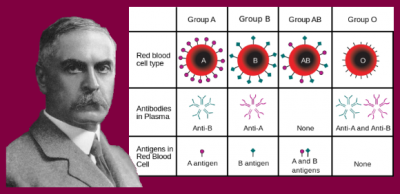
In 1897, Landsteiner accepted a position at the Institute of Pathological Anatomy in Vienna, where he worked on cadavers. Over the next ten years he performed nearly four thousand post-mortem examinations and published over seventy-five articles on his observations. Fifty-two of these articles discuss blood chemistry. Landsteiner described the agglutination reactions that occur when blood from one individual is brought into contract with the blood of another individual. Landsteiner relegated his observation of agglutination to a footnote in a paper he wrote in 1900, but he expanded upon this observation the following year in his paper “Agglutination of Normal Human Blood.”
Landsteiner observed a pattern of antigen reactions that occurred when he combined blood serum from different individuals. Landsteiner observed that antigens on the outside of blood cells differed between individuals. If blood from what he called the A or the B group was introduced into a host of the opposing group, the host body would trigger an immunological reaction. Landsteiner found that this reaction caused the invading antigen carrying blood cell to burst. Large accumulations of burst cells created clumps that could clog small blood vessels (capillaries) and perhaps cause shock or death. Initially, Landsteiner recognized three different blood types: A, B, and C. The C-blood type was later more commonly called type-O. In 1902, one of Landsteiner’s students found a fourth blood type, AB, which triggered a reaction if introduced into either A or B blood. In 1930, The Health Committee of the League of Nations in Geneva, Switzerland, formally adopted the Landsteiner nomenclature (A, B, AB, and O) in his honor, the naming convention that was still used up through the first decades of the twenty-first century.
Landsteiner’s blood typing system had an immediate impact on forensic and surgical sciences. In 1902, Landsteiner and Max Richter, who worked at Vienna University Institute of Forensic Medicine in Vienna, described a method of using blood evidence gathered from the scene of a crime to aid in the investigation. Using this system, scientists could determine whether a blood sample contained A-antigen, B-antigen, both A- and B-antigen, or neither antigen (type-O). If a suspect’s blood had a different antigen than the sample left at the crime scene, investigators could conclude the sample could was not from that particular individual. However, roughly fifty percent of the population has O-type blood and less than five percent has AB-type blood. So, if a sample and a suspect had matching blood types, investigators could not make a positive identification. The ABO system also enabled doctors to perform safe blood transfusions. Reuben Ottenberg at the Mt. Sinai Hospital in New York, New York, completed the first successful blood transfusion based on Landsteiner’s blood type theory in 1907. During World War I, blood transfusions saved tens of thousands of lives. Later, the ABO blood grouping made it possible to successfully complete the first organ transplants by reducing the chance that a body rejected incompatible transplants.
Credit : The Embryo Project
Picture Credit : Google




